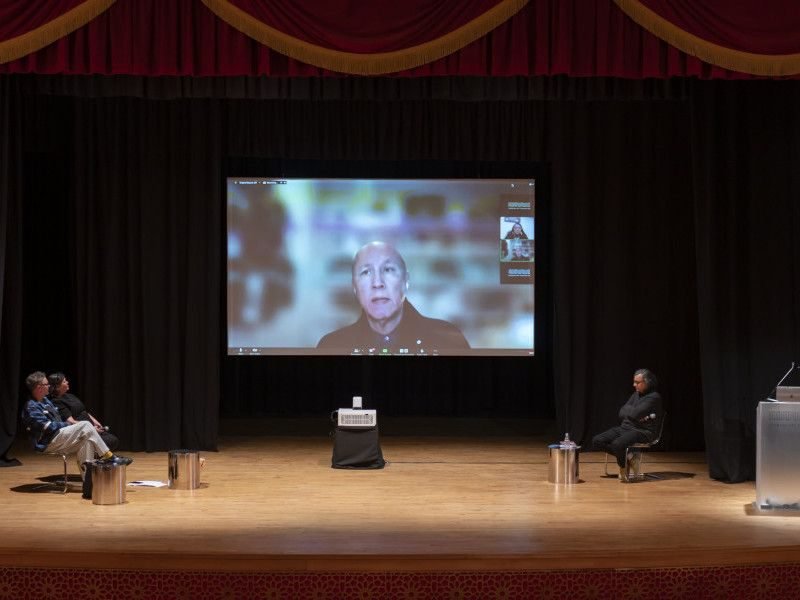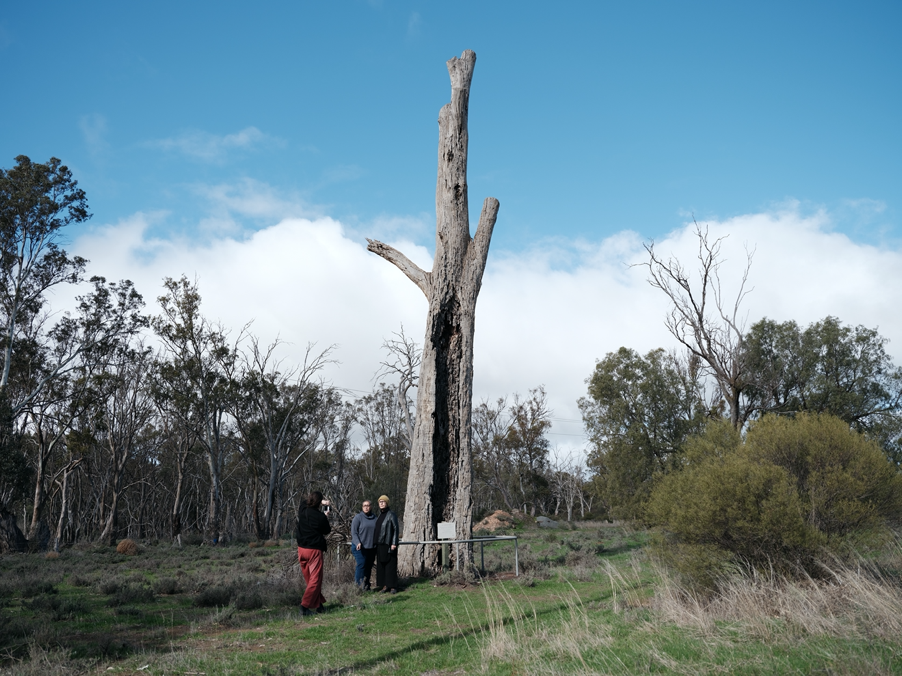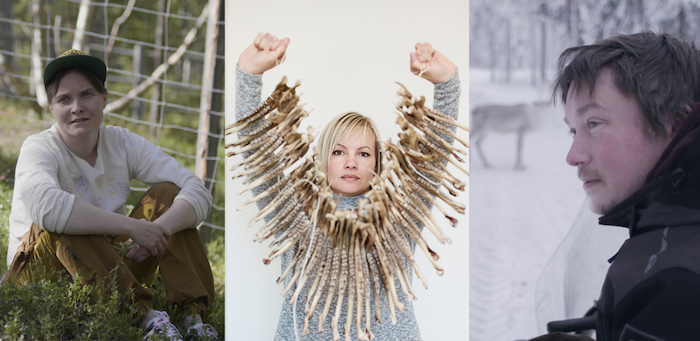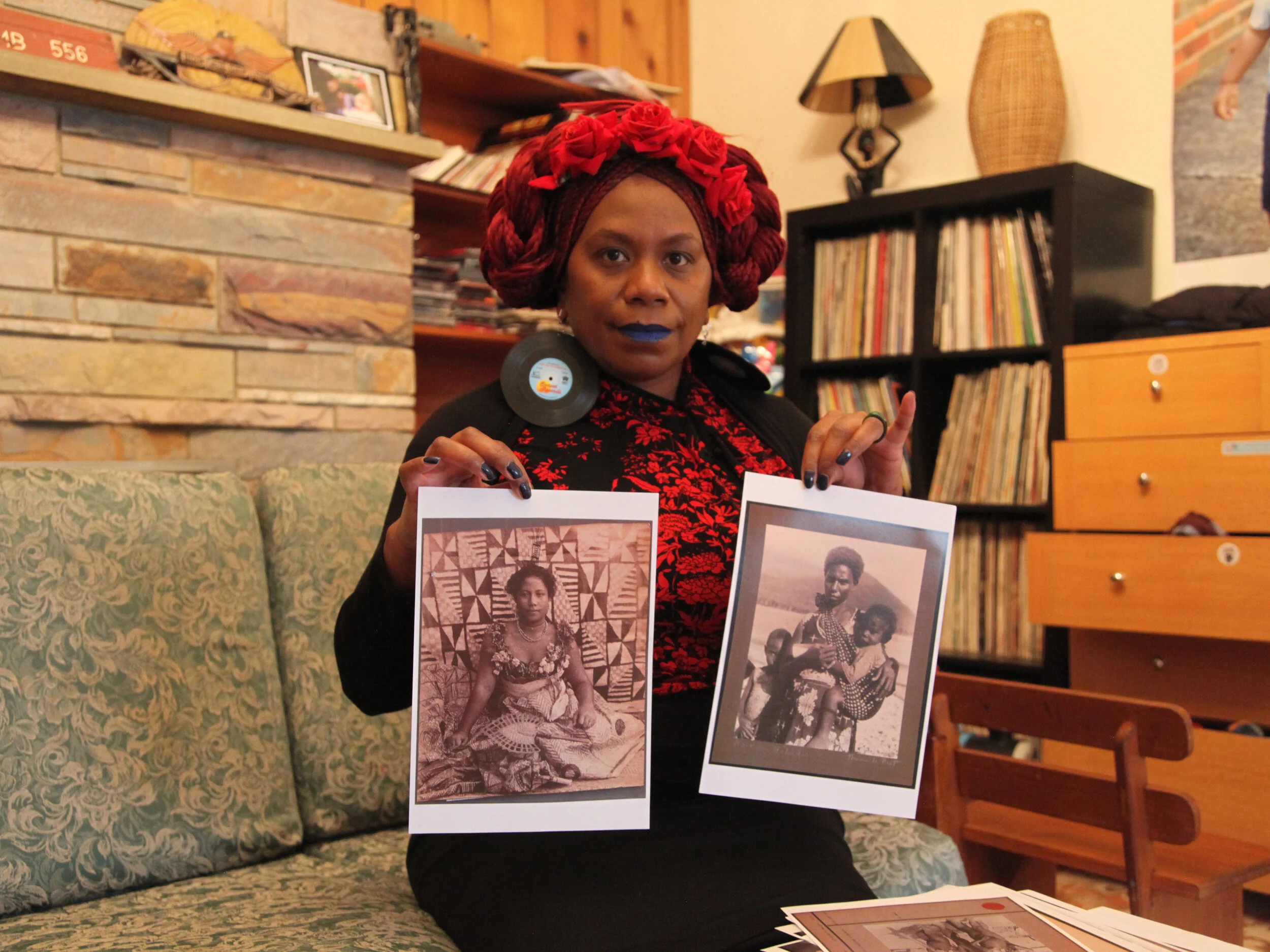waa-lanha / world actions
Conversation
Photo de David Janesko during the 1st Tree Dance–ARBOReusement (TREELY) by Katy’taya Catitu Tayassu performed in 2014, at the Palais de Tokyo, in NUEVO MUNDO, Paris. Courtesy of the artist.
Indigenous Visions @ Venice Biennale
Centro Culturale Don Orione Artigianelli, Venice
Tuesday 16 April, 10am – 6pm
Brook recently curated the seminar program Indigenous Visions at the Venice Biennale which included conversations with Abdullah Al Saadi, Ahmed Umar, Denilson Baniwa, Gregor Muir, Hoor Al Qasimi, Iaroslav Volovod, Katy’taya Catitu Tayassu, Kimberley Moulton, Léuli Eshrāghi, Megan Tamati-Quennell, Michaelangelo Corsaro, Natalia Papaeva, Nicholas Galanin, Pedro Wonaeamirri, Paschal Daantos Berry, Raphael Fonseca, Rose Hiscock, Rushdi Anwar, Wanda Nanibush, Will Heathcote, Simon Mordant, Stephanie Rosenthal, Elena Sorokina
The seminar was an opportunity to promote and support a collaborative network that from the grassroots of Indigenous ways of being expands within the space of the institutional.
Indigenous Visions was presented by BLAK C.O.R.E., University of Melbourne (Museums and Collections Department), in collaboration with Guggenheim Abu Dhabi. BLAK C.O.R.E. is supported by the Mordant Family.
Publication
Tremors, conversation between Brook Andrew and Pablo José Ramírez
e-flux Criticism
7 December 2020
“The following conversation explores the possibility of indigenous art as a non-colonial force, one that fractures the idea of history as progress and questions the art-historical canon and the institutions that enshrine it. These themes are evident across Andrew’s research-based artistic practice, in which he engages with themes of colonialism, indigeneity, and historical amnesia in collage, painting, and installation. Something that has always impressed me about his practice is the joy with which he approaches such issues—with care and rigor, and with the soul of someone waiting to be amazed.”
Read full conversation here: https://www.e-flux.com/criticism/365501/tremors
Conversation
Gerald McMaster speaking via Zoom during 'Persistent Structural Inequalities: Indigeneity and Sovereignty', a panel with Brook Andrew and Megan Tamati-Quennell, moderated by Iftikhar Dadi at March Meeting, Sharjah Art Foundation (4 March–4 July 2022). Jolene Rickard joined the panel online via Zoom. Photo: Shanavas Jamaluddin.
March Meeting 2022: The Afterlives of the Postcolonial
5-7 March 2022
Brook participated in the 14th edition of March Meeting, an annual gathering of artists, curators and art practitioners presented by Sharjah Art Foundation. Under the banner of The Afterlives of the Postcolonial, this year’s March Meeting focused on the critical issues within contemporary art in light of persistent legacies of colonialism and postcolonial studies.
Find out more about the talk here. Ocula also reviewed the meeting here.
International conference
Brook Andrew, guulany 11 (Wemba Wemba) with L-R Jessica Neath, Jacinta Elston and N’Arweet Carolyn Briggs, 2021. Digital photograph.
More than a guulany (tree): Aboriginal Knowledge Systems
Decolonizing Provenance Research, 24-25 November 2021
Musée d’ethnographie de Genève
Geneva, Switzerland
Brook, Brian Martin, Roslyn McGregor and Kimberley Moulton shared their research on the significance of trees in southeast Australian Aboriginal cultures at the recent Decolonizing provenance research conference, presented by Musée d’ethnographie de Genève.
“Due to the impacts of colonialism including the removal of cultural objects for colonial collections, the destruction of culturally significant trees, and the forced removal of peoples from their traditional Country, access to our cultural heritage has been severely disrupted… the authors… are inspired by the knowledge of trees which surfaces through their relationality with Country, peoples, other beings and cultural practices. The research includes connecting source communities with ancestral objects in museum collections including carved tree sections and shields and identifying living trees and cultural practices that speak to this significance. Through an Indigenous-led methodology, and by using methods of collaborative art and exhibition making, the research aims to articulate the agency of trees in an expanded conception of cultural heritage, and in a reimagining of the future of colonial collections.” Extract from the abstract for the presentation.
Watch the talk here.
Writing
“The Blacktown Native Institution as a Living, Embodied Being: Decolonizing Australian First Nations Zones of Trauma Through Creativity“
February 2022
Brook Andrew and Lily Hibberd
Special issue, Place, Memory & Justice: Critical Perspectives on Sites of Conscience of the journal Space and Culture
“In Australia, the trauma of the forced removal, institutionalisation, and attempted assimilation of Aboriginal and Torres Strait Islander children under Stolen Generations policies is rarely publicly memorialized, especially at the children’s homes and missions where these things took place. Darug Nation reclamation of the former site of the Blacktown Native Institution in Western Sydney entails, however, a distinct memorialization of the land as a powerful identity through restoring ceremonial and land care cultural practices that predate invasion. ” Extract from the abstract
Read the full piece here.
This article was an outcome of the project Representation, Remembrance and the Memorial, funded by the Australian Research Council Indigenous Discovery Program (2016–2018) and hosted by Monash University. Find out more about the project here.
Recidency
Residency with Art Explora x Cité internationale des arts, Paris
Brook has been selected to participate in the Art Explora x Cité internationale des arts 2022 residency program in Paris. During his residency, Brook will continue his creative research about the repatriation and restitution of cultural objects found in museums and work towards his solo exhibition at the Galerie Nathalie Obadia (see above).
Gathering
aabaakwad 2022
22-25 April
aabaakwad is a yearly international gathering of Indigenous artists, curators and thinkers. Indigenous-led conversations investigate the themes, materials and experiences in Indigenous art practice. Brook is currently on the international curatorial committee of aabaakwad.
This year, aabaakwad 2022 will be taking place at the the 59th International Art Exhibition of La Biennale di Venezia.
Biennale
Pauliina Feodoroff, Máret Ánne Sara, Anders Sunna.
The Sámi Pavilion, Venice Biennale: Wanda Nanibush and Brook Andrew are international Indigenous advisors
2022
In an historic first, the Nordic Pavilion in Venice is transforming into 'The Sámi Pavilion', with a project commissioned by Office for Contemporary Art Norway (OCA) featuring the Sámi artists Pauliina Feodoroff, Máret Ánne Sara and Anders Sunna during the 59th International Art Exhibition of La Biennale di Venezia in 2022. This transformation of the Nordic Pavilion celebrates the art and sovereignty of the Indigenous Sámi people, whose nation extends across the Nordic countries and into the Kola Peninsula in Russia. Curated by Sámi scholar Liisa-Rávná Finbog, OCA’s Director Katya García-Antón and Sámi land guardian Beaska Niillas. Brook and Wanda have been advising the artists and curators for the presentation for the Sámi Pavillion.
MORE THAN A GUULANY (tree): INDIGENOUS KNOWLEDGE SYSTEMS, Australia 2021-2024
More than a guulany (tree): Indigenous Knowledge systems is a three-year project that brings together the research of Dr Brian Martin and Associate Professor Brook Andrew to produce an Indigenous-led study about the significance of trees in southeast Australian Aboriginal cultures. Funding has been received from the Australian Research Council’s Special Research Initiative for Australian Society, History and Culture and the project is based at the Wominjeka Djeembana research lab, Faculty of Art, Design and Architecture, Monash University.
We hope to identify evidence of this significance and generate new methods in art-making and exhibition development to improve the awareness and understanding of Indigenous cultural heritage and Indigenous Knowledge. This should provide significant benefits such as better recognition of the complexities of southeast Australian Aboriginal cultures, improved access for Aboriginal communities to cultural materials in institutional collections and new insights and resources for arts, heritage and museum professionals to engage appropriately with our heritage and knowledge.
You can hear more about the research here:
Form x Content – More than a guulany (tree): Indigenous knowledge systems Artists Dr Brian Martin and Associate Professor Brook Garru Andrew in conversation
Publication - essay
Brook was invited to write the catalogue essay for Mohamed Bourouissa’s exhibition Brutal Family Roots at Kamel Mennour, Paris, 4 September — 24 October 2020 Link to pdf here
“The experience as a child, being in a place and becoming emotionally attached to plants, people, smells, movements and languages, is often the foundation that becomes conflicted once we start to move around the world. Plants, like humans, drop their seeds and sprout new lands, or are removed, relocated and transported to be planted in places far from their ancestors.”
Publication - discussion about NIRIN, the 22nd Biennale of Sydney
The September issue of di’van: a Journal of Accounts features a discussion between Brook Andrew and Andrew Renton about NIRIN, the 22nd Biennale of Sydney, and the play of Powerful Objects in the exhibitions. Link to pdf here
“NIRIN was always going to be artist and First Nations led, underpinned by a strong advocacy for a First Nations philosophical context, initiated by the word “NIRIN”, which means ‘edge’ in my Wiradjuri language. This doesn’t mean that non-Indigenous artists in the Biennale couldn’t understand or embrace the themes. First Nations philosophy draws from deep history and connection to place and more recent manifestations like the terminology “blak/blakness” coined by Australian Indigenous artist Destiny Deacon; blak is a self-empowering self-labelling action of pride.”
Brook Andrew
Pitt Rivers Museum, Oxford | 2018 - ongoing
Associate Researcher Pitt Rivers Museum, Oxford, UK.
NIRIN 22nd Biennale of Sydney | 2020
Artistic Director
As Artistic Director, I am interested in shining a light on the active, stable and rich pre-existing collaborations and connectivity of Indigenous and Edge cultures. I aim to work together with artists, collectives and communities, from Australia and around the globe, to reconfigure the world as we see it and reveal rich local and global rhizomes and unique individual cultural expressions in one place.
Publication — conversation piece featuring a response by Brook Andrew
Saloni Mathur, "Why Exhibition Histories?", British Art Studies, Issue 13, September 2019. Link here
"A number of exhibitions in the past few decades have attempted to address the histories of exclusion referred to by Saloni Mathur. A notable example was the 2015 Tate Britain exhibition Artist and Empire: Facing Britain’s Imperial Past, which included an artwork of mine. While an exhibition might speak to themes of the global—and include artworks by “other” makers—this by itself does not make for a radical activity that undoes the canon. To be antagonistic towards histories of imperialism, through an exhibition, involves a dismantling of the institution itself."
REPRESENTATION, REMEMBRANCE AND THE MEMORIAL, Australia | 2016 – 2018
Representation, Remembrance and the Memorial, http://www.rr.memorial, is an international visual arts research project that concerns the Australian frontier wars and the possibility of representing the magnitude of Indigenous loss and survival in a national memorial. The project is led by Brook Andrew, with research assistant Dr Jessica Neath and mentored by Professor Marcia Langton. The project follows several lines of enquiry including investigating international examples of monuments to genocide and community approaches to remembering frontier violence. Research activities and outcomes include interviewing memorial experts, site visits, archival research, hosting a forum, developing artworks, and publications. RRM is funded by a grant from the Australian Research Council Indigenous Discovery Program (2016–2018) and is hosted by MADA, Monash University. The project is based in Melbourne, Australia. We acknowledge the people of the Kulin Nation as the Traditional Owners of the land on which our office and studio resides.
Publication - journal article
“Encounters with Legacy Images: Decolonising and Re-imagining Photographic Evidence from the Colonial Archive” by Brook Andrew and Jessica Neath in the journal History of Photography, Volume 42, 2018 - Issue 3: Indigenous Photographies.
Link here
“By way of a dialogue between the two authors – an artist and an art historian – this article reflects on the artistic method of repurposing the colonial archive, in particular the vast collection of photographs of Aboriginal and Torres Strait Islander peoples. Important contexts for this work include the international practice, established in the 1990s amongst artists, communities, and museums, of addressing hidden histories of war and genocide in the public sphere.”
Künstlerhaus Bethanien residency, Berlin | July 2017 - June 2018
On residency at Künstlerhaus Bethanien, Berlin. Research on the representation of Australian Indigenous loss by learning from German memorials relating to genocide and fascism. This project is motivated by the lack of memorials to the frontier wars in Australia where in-numerous first peoples were murdered and in the aftermath - cultural genocide. This work does not compare historical traumas but investigates the methods of display: how have artists, architects, communities and institutions in Germany and surrounding Europe made traumatic histories visible in the public sphere?
Smithsonian Artist Research Fellowship (SARF), Washington DC | October 2017 - December 2017
Research the National Anthropological Archives and Human Studies Film Archives in the Department of Anthropology at the Smithsonian Institute, Washington, DC, part of his Smithsonian Artist Research Fellowship (SARF). The extensive collection on ethnology, field-notes, correspondence, photographs, sound recordings, film and video in these archives, extends Brook's current and past research, specifically at the Pitt Rivers Museum, Oxford; Museum of Archaeology and Anthropology, Cambridge; and the Anthropology Department Collection, University of Vienna.
Present Elsewhere. A collaborative project with the Asia Art Archive, Hong Kong | 2017
Invited by Rashid Rana, the Pakistan-based artist to participate in Present Elsewhere - an inquiry into the possibilities of fiction to construct multiple pasts through notes, images, and schematic representations of his collaborative work-in-progress. Link to publication here.
Photography Residencies Laureate, musée du quai Branly, Paris, France | 2015
In 2015 as a Photography Residencies Laureate at the musée du quai Branly, Paris, Brook researched the museum’s photographic collections to explore the relationship between the colonial photographer and the ethnographic subject, most often an Indigenous person. His 2016 photographic series The Visitor and the Resident draws from this research to reimagine these encounters.
Brook Andrew, Resident and Visitor (Namila Benson), 2016 from the series ‘The Visitor and the Resident’, 10 colour photographic prints.
Standing By Tunnerminnerwait and Maulboyheener. Collaboration with Trent Walter. City of Melbourne Public Art Commission | 2016
Brook Andrew with his collaborator Trent Walter, created the public artwork Standing By Tunnerminnerwait and Maulboyheener in 2016. Installed adjacent Melbourne Gaol, this is Australia’s first official government supported memorial to the frontier wars. Read a reflection on the project here.
Les Récollets. Residency hosted by the City of Paris and Institut Francis | 2016
On residency at Les Récollets in Paris Brook developed new artwork for a major solo exhibition at Galerie Nathalie Obadia, titled The Forest. Throughout the residency, he collaborated with Photographic curator Christine Barthe of the musée du Quai Branly, curator Valentine Meyer and French anthropologist Barbara Glowczewski. Glowczewski and Barthe’s investment in Australia and the context for France provided unique and valuable insight into the legacy of international study and reflection on indigenous cultures.
The new work explored the space between cultures and the desire to be ‘in the middle’. It further questioned if this space indeed exists. Brook states: "The work drew upon my own experience, coming from Wiradjuri (Australian Aboriginal) and Celtic ancestry, and the manifested expectations formed within these so-called ‘immensely different’ cultures. Reflection within this space is often curious regarding the manifested expectations of how my culture or body should be. The desire and fascination with difference is a powerful place to work within."
Centre Intermondes. Artist residency, La Rochelle, France | 2016
On residency at Centre Intermondes, La Rochelle, Brook Andrew undertook research at ‘France Archives departementales Charente-Maritime’. The documents accessed here connected to documents from British/Australian slave owners from the early 19th Century held in the University of Melbourne archives. This research informed two solo exhibitions in Australia: Sanctuary: The Tombs of the Outcasts, at the Ian Potter Museum, Melbourne; and EVIDENCE at the Museum of Applied Art and Sciences (MAAS), Sydney. This residency was supported by Creative Victoria and Australia Council for the Arts.
Asialink Arts Residency, Cambodia | 2016
Residency at Sa Sa Art Projects, Phnom Penh, Cambodia for research at the Choeung Ek memorial and the Tuol Sleng Genocide Museum (S-21 Prison). Meetings and interviews with members of the Documentation Centre of Cambodia. This research was supported by Creative Victoria and fed into his research for Representation, Remembrance and the Memorial (RRM).





